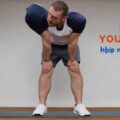The Importance of Hip-Opening Stretches for Overall Wellness
Welcome to our comprehensive guide on hip-opening stretches! In today’s fast-paced world, many of us spend long hours sitting, which can lead to tight hips and a host of related issues. Hip-opening stretches are not just about physical flexibility; they’re a gateway to overall wellness, both for your body and mind. Let’s explore how these gentle yet powerful movements can transform your daily life, bringing more ease, comfort, and joy to your movements.
Understanding the Hip Joint and Its Impact on Your Body
The hip joint is one of the largest and most important joints in our body. It’s responsible for bearing our weight and allowing us to walk, run, and move with ease. When our hips are tight, it can affect our entire body – from our lower back to our knees and even our posture. By focusing on hip-opening stretches, we’re not just working on one area; we’re positively influencing our entire physical structure.
Hip-opening stretches can help:
- Improve posture and alignment
- Reduce lower back pain
- Enhance flexibility and range of motion
- Alleviate tension in the surrounding muscles
- Boost circulation in the pelvic area
Gentle Hip-Opening Stretches for Beginners
If you’re new to hip-opening stretches, don’t worry! We’ll start with some gentle, accessible movements that anyone can try. Remember, the key is to move with kindness and respect for your body. Never push into pain, and always listen to what your body is telling you.
- Butterfly Stretch: Sit on the floor, bring the soles of your feet together, and gently press your knees towards the ground. Hold for 30 seconds to 1 minute, breathing deeply.
- Figure Four Stretch: Lie on your back, cross your right ankle over your left knee, and gently pull your left thigh towards your chest. Hold for 30 seconds, then switch sides.
- Child’s Pose: Kneel on the floor, sit back on your heels, and reach your arms forward, lowering your chest to the ground. This stretch not only opens the hips but also provides a calming effect.
Deepening Your Practice: Advanced Hip-Opening Stretches
As you become more comfortable with basic hip-opening stretches, you might want to explore more challenging poses. Remember, the goal isn’t to achieve a perfect pose, but to find what feels good and beneficial for your unique body.
- Pigeon Pose: From a downward-facing dog position, bring one leg forward and place it behind your wrist. Lower your hips and extend your back leg. This deep stretch targets the hip flexors and outer hips.
- Frog Pose: Start on all fours, then slowly widen your knees as far as comfortable, keeping your ankles in line with your knees. Lower onto your forearms if possible. This pose provides an intense inner thigh and groin stretch.
- Half Split: From a low lunge, straighten your front leg and fold forward over it. This stretch targets the hamstrings and can help release tension in the lower back.
Incorporating Hip-Opening Stretches into Your Daily Routine
The beauty of hip-opening stretches is that they can be easily incorporated into your daily life. You don’t need special equipment or a lot of time. Here are some ideas:
- Start your day with a few minutes of gentle stretching in bed
- Take stretch breaks during long periods of sitting
- Use commercial breaks during TV time to do some floor stretches
- Wind down before bed with calming hip openers to promote better sleep
Remember, consistency is key. Even a few minutes of daily stretching can make a significant difference in how you feel and move.
The Mind-Body Connection: How Hip-Opening Stretches Affect Your Emotional Well-being
Hip-opening stretches aren’t just beneficial for your physical body; they can have a profound impact on your emotional well-being too. In many traditions, the hips are considered to be a storage area for emotions, particularly stress and anxiety. When we open and release tension in the hips, we may also release pent-up emotions.
Many people report feeling a sense of emotional release or even experiencing unexpected emotions during deep hip stretches. This is completely normal and can be a powerful part of your wellness journey. Approach these experiences with curiosity and compassion for yourself.
Some ways hip-opening stretches can support emotional well-being include:
- Reducing stress and anxiety
- Promoting feelings of groundedness and stability
- Enhancing body awareness and mindfulness
- Boosting mood and energy levels
- Improving sleep quality
Frequently Asked Questions About Hip-Opening Stretches
1. How often should I do hip-opening stretches?
Ideally, incorporating hip-opening stretches into your daily routine is beneficial. Even 5-10 minutes a day can make a significant difference. However, listen to your body and adjust the frequency based on how you feel.
2. Are hip-opening stretches safe for everyone?
While hip-opening stretches are generally safe, it’s always best to consult with a healthcare professional if you have any existing hip issues, injuries, or health concerns. Always listen to your body and avoid any movements that cause pain.
3. Can hip-opening stretches help with lower back pain?
Yes, many people find that regular hip-opening stretches can help alleviate lower back pain. Tight hips can contribute to lower back issues, so releasing tension in the hips often provides relief for the back as well.
4. How long should I hold each stretch?
For most hip-opening stretches, holding for 30 seconds to 2 minutes is beneficial. However, start with shorter durations and gradually increase as you become more comfortable with the stretches.
5. Can I do hip-opening stretches if I’m not flexible?
Absolutely! Hip-opening stretches are for everyone, regardless of flexibility level. Start with gentle stretches and focus on what feels good for your body. Flexibility will improve with consistent practice.
Remember, the journey of opening your hips is a personal one. It’s not about achieving a certain pose or level of flexibility, but about moving with awareness, kindness, and respect for your body. As you incorporate these stretches into your routine, pay attention to how they make you feel both physically and emotionally. Celebrate the small changes and improvements you notice along the way. Here’s to happier, healthier hips and a more balanced you!









